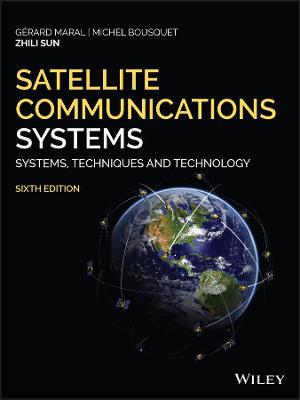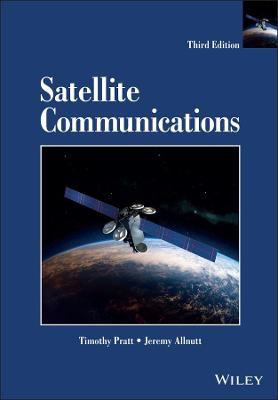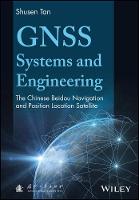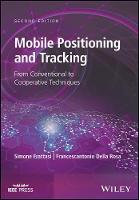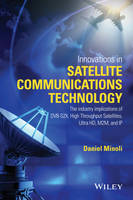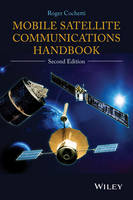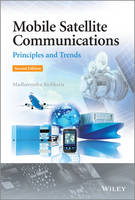5G Non-Terrestrial Networks
 -10%
portes grátis
-10%
portes grátis
5G Non-Terrestrial Networks
Technologies, Standards, and System Design
Vanelli-Coralli, Alessandro; Chuberre, Nicolas; El Jaafari, Mohamed; Guidotti, Alessandro; Masini, Gino
John Wiley & Sons Inc
01/2024
336
Dura
Inglês
9781119891154
15 a 20 dias
666
About the Authors xvii
Acknowledgments xxi
Acronyms xxv
1 Introduction 1
1.1 What is 5G NTN? 3
1.2 Use Cases for 5G NTN 7
1.3 ITU-R Vision and Requirements on the Satellite Component of IMT-2020 9
1.3.1 Satellite Component of IMT-2020: Usage Scenarios 9
1.3.2 Requirements for the Satellite Radio Interface(s) of IMT-2020 9
1.4 NTN Roadmap in 3GPP 11
1.5 3GPP Requirements for 5G via Satellite 13
1.6 Technical Challenges 13
1.7 Satellite RAN Architecture 15
1.8 NTN Spectrum 17
1.9 3GPP Work on NTN in Release-15 and Release-16 19
1.10 3GPP work on NTN in Release-17 and Release-18 21
1.11 NTN in Release-19 and Beyond 32
1.12 3GPP and Standardization 33
References 36
2 The 3GPP 5G Overview 39
2.1 Introduction 39
2.2 5G System Architecture 40
2.2.1 5G Core Network 40
2.2.2 NG Radio Access Network 41
2.2.3 Dual Connectivity 42
2.2.4 Connectivity Options 43
2.2.5 Split Architecture 44
2.2.5.1 CU-DU Split 44
2.2.5.2 CP-UP Split 46
2.2.6 IoT and MTC Aspects 47
2.3 3GPP and 5G Standardization 48
References 49
3 Non-Terrestrial Networks Overview 53
3.1 Elements of a Satellite Communications System 53
3.2 Orbits and Constellations 55
3.2.1 Principles of Orbital Motion 55
3.2.2 Types of Orbits 60
3.2.3 Constellation Design 65
3.2.4 Satellite Orbit Determination and Prediction 67
3.3 Propagation and Link Performance 69
3.3.1 Earth-Satellite Geometry 69
3.3.1.1 Delay Characterization 72
3.3.1.2 Doppler Characterization 76
3.3.2 Link Performance 77
3.3.2.1 Antenna Parameters and Received Power 78
3.3.2.2 Additional Losses 79
3.3.2.3 Individual Link Performance 81
3.3.2.4 Overall Link Performance 82
3.3.2.5 NTN Link Budget Examples 82
References 89
4 NR NTN Architecture and Network Protocols 91
4.1 Introduction 91
4.2 Architecture Overview 91
4.2.1 NG Interface Functions 94
4.2.2 Xn Interface Functions 95
4.3 User Plane and Control Plane 96
4.3.1 Control Plane 96
4.3.2 User Plane 97
4.4 Interworking with Terrestrial Mobile Networks 98
4.4.1 Mobility 98
4.4.2 Dual Connectivity 99
4.5 Impact on Other Technologies: IoT NTN 99
4.6 Regenerative Architectures 100
4.6.1 NG-RAN Node on Satellite 101
4.6.2 Split Architectures 102
4.6.2.1 CU-DU Split 103
4.6.2.2 Lower-layer Split 104
4.7 Conclusions 108
References 109
5 NR NTN Radio Interface 111
5.1 Introduction 111
5.2 NR Basic Transmission Scheme 112
5.2.1 NR Waveform 112
5.2.2 Modulation and Coding Scheme 114
5.2.3 Channel Coding 114
5.2.4 NR Multiple Access Scheme 114
5.2.5 NR Frame Structure 115
5.2.6 Bandwidth Part Operation 117
5.2.7 NR Radio Channels 117
5.2.8 NR Reference Signals 119
5.2.9 Multi-antenna System 120
5.2.9.1 MIMO Schemes 120
5.2.9.2 Beam Management 121
5.2.9.3 Polarization Signaling in NTN 121
5.3 Downlink Synchronization Procedure in NTN 123
5.4 Uplink Synchronization Procedure in NTN 124
5.4.1 Uplink Timing Control 124
5.4.1.1 Uplink Timing Control in NR TN 125
5.4.1.2 Uplink Timing Control in NR NTN 127
5.4.1.3 NTN Higher-layer Parameters for Uplink Timing Control 132
5.4.1.4 Timing Advance Adjustment Delay 142
5.4.2 Uplink Frequency Synchronization 145
5.5 NR Timing Relationships Enhancements for NR NTN 147
5.5.1 Timing Relationships Enhanced With Koffset 147
5.5.1.1 Random-access Procedure in NTN 150
5.5.1.2 Resource Allocation in Time Domain 154
5.5.1.3 Other Timing Relationships Enhanced With Koffset 156
5.5.2 Timing Relationships Enhanced With kmac 158
5.5.2.1 Uplink Power Control 162
5.5.2.2 Beam Failure Recovery 163
5.6 Hybrid ARQ Enhancements for NR NTN 164
5.6.1 HARQ Functionality Basics 164
5.6.2 Increasing the Number of HARQ Processes in NTN 166
5.6.3 Disabling HARQ Feedback in NTN 170
5.6.3.1 Disabling HARQ Feedback Activation 170
5.6.3.2 HARQ ACK Codebook Enhancements 171
5.6.4 Transmission Timing for HARQ-ACK on PUCCH 175
5.6.4.1 Transmission Timing for HARQ-ACK on PUCCH in Terrestrial Network 175
5.6.4.2 Transmission Timing for HARQ-ACK on PUCCH in NTN 176
5.6.4.3 PDSCH Scheduling Restriction 177
References 179
6 Impacts on the System Architecture and Network Protocol Aspects 181
6.1 Introduction 181
6.2 5G QoS and NTN 181
6.3 Network Attach, AMF Selection, and UE Location 183
6.3.1 Network Identities 183
6.3.2 Multiple TACs Support 184
6.3.3 UE Attach and Location Verification 185
6.4 Random-access Procedure 186
6.5 Other Enhancements at MAC 189
6.5.1 Hybrid ARQ Operation Enhancements 189
6.5.2 Logical Channel Prioritization Enhancements 190
6.5.3 Enhancements on DRX Functionality 191
6.5.4 Extension of Other MAC Timers 192
6.6 RLC, PDCP Enhancements 193
6.6.1 RLC Sublayer 193
6.6.2 PDCP Sublayer 194
6.7 NTN-specific System Information 194
6.8 Mobility Aspects 196
6.8.1 Idle Mode and Inactive Mode Mobility 196
6.8.1.1 Location-based Measurement 199
6.8.1.2 Time-based Measurement 199
6.8.2 Connected Mode Mobility 200
6.8.2.1 RRM Enhancements 201
6.8.2.2 Conditional Handover 203
6.9 Feeder Link Switchover 203
6.10 Network Management Aspects 205
References 211
7 RF and RRM Requirements 213
7.1 Frequency Bands In Which NTN Can Operate 213
7.1.1 Satellite Networks 213
7.1.2 HAPS-based Networks 216
7.2 NTN Architecture and Interfaces 217
7.3 Definition of RF Performances and Related Methodology 219
7.3.1 Coexistence Analysis 224
7.3.2 RF Performances 224
7.4 RRM Requirements 226
7.4.1 System Aspect 226
References 229
8 NB-IoT and eMTC in NTN 231
8.1 Overview 231
8.1.1 Cellular IoT in 3GPP Roadmap 233
8.1.2 Study Item on IoT NTN 236
8.1.3 Normative Work on IoT NTN 237
8.2 Architecture and Deployments Scenarios 237
8.2.1 Potential Use Cases 237
8.2.2 System Architecture 238
8.2.3 NTN IoT Spectrum 242
8.3 Enhancements for NB-IoT/eMTC Support in NTN 243
8.3.1 Timing and Frequency Pre-compensation 243
8.3.1.1 Uplink Synchronization Validity Duration 247
8.3.1.2 GNSS Operation in IoT NTN 247
8.3.2 Timing Relationship Enhancements 250
8.3.3 Discontinuous Coverage and Assistance Information 253
8.3.4 Mobility Management 255
8.3.5 Feeder-link Switchover 256
8.3.6 Network-interfaces Signaling Aspects 256
8.3.7 MME(Re-)Selection by eNB 257
8.3.8 Verification of UE Location 257
8.3.9 O&M Requirements 257
8.3.10 Other NAS Protocol Aspects 257
References 258
9 Release 18 and Beyond 261
9.1 NTN in the Evolving Context of 5G, Beyond 5G and 6G 261
9.2 Non-Terrestrial Networks and 5G 261
9.2.1 3GPP Standardization Status 261
9.2.2 Industrial Projects Based on Rel-17 and Rel-18 264
9.2.2.1 Direct Connectivity to Smartphones 264
9.2.2.2 Direct Connectivity to IoT Devices 265
9.2.2.3 Connectivity to Cell 265
9.3 Toward 6G and Non-Terrestrial Networks 266
9.3.1 6G System Versus 5G System 266
9.3.2 6G Versus 5G Non-Terrestrial Network Component 269
9.3.3 6G NTN Design Principles 271
9.3.3.1 Multi-terminal Types and Usage Conditions 272
9.3.3.2 Multi-mission Radio Protocol(s) 272
9.3.3.3 Multi-dimensional Network Infrastructure 273
9.3.3.4 Multi-constraints Radio Access Network 274
9.3.3.5 Unification With the Terrestrial Network Component 275
9.3.4 Possible Evolution of NTN Standards 275
9.3.4.1 Enhancements of NTN 5G-Advanced in 3GPP 275
9.3.4.2 Potential Enhancements of NTN for 6G 277
References 278
Index 281
About the Authors xvii
Acknowledgments xxi
Acronyms xxv
1 Introduction 1
1.1 What is 5G NTN? 3
1.2 Use Cases for 5G NTN 7
1.3 ITU-R Vision and Requirements on the Satellite Component of IMT-2020 9
1.3.1 Satellite Component of IMT-2020: Usage Scenarios 9
1.3.2 Requirements for the Satellite Radio Interface(s) of IMT-2020 9
1.4 NTN Roadmap in 3GPP 11
1.5 3GPP Requirements for 5G via Satellite 13
1.6 Technical Challenges 13
1.7 Satellite RAN Architecture 15
1.8 NTN Spectrum 17
1.9 3GPP Work on NTN in Release-15 and Release-16 19
1.10 3GPP work on NTN in Release-17 and Release-18 21
1.11 NTN in Release-19 and Beyond 32
1.12 3GPP and Standardization 33
References 36
2 The 3GPP 5G Overview 39
2.1 Introduction 39
2.2 5G System Architecture 40
2.2.1 5G Core Network 40
2.2.2 NG Radio Access Network 41
2.2.3 Dual Connectivity 42
2.2.4 Connectivity Options 43
2.2.5 Split Architecture 44
2.2.5.1 CU-DU Split 44
2.2.5.2 CP-UP Split 46
2.2.6 IoT and MTC Aspects 47
2.3 3GPP and 5G Standardization 48
References 49
3 Non-Terrestrial Networks Overview 53
3.1 Elements of a Satellite Communications System 53
3.2 Orbits and Constellations 55
3.2.1 Principles of Orbital Motion 55
3.2.2 Types of Orbits 60
3.2.3 Constellation Design 65
3.2.4 Satellite Orbit Determination and Prediction 67
3.3 Propagation and Link Performance 69
3.3.1 Earth-Satellite Geometry 69
3.3.1.1 Delay Characterization 72
3.3.1.2 Doppler Characterization 76
3.3.2 Link Performance 77
3.3.2.1 Antenna Parameters and Received Power 78
3.3.2.2 Additional Losses 79
3.3.2.3 Individual Link Performance 81
3.3.2.4 Overall Link Performance 82
3.3.2.5 NTN Link Budget Examples 82
References 89
4 NR NTN Architecture and Network Protocols 91
4.1 Introduction 91
4.2 Architecture Overview 91
4.2.1 NG Interface Functions 94
4.2.2 Xn Interface Functions 95
4.3 User Plane and Control Plane 96
4.3.1 Control Plane 96
4.3.2 User Plane 97
4.4 Interworking with Terrestrial Mobile Networks 98
4.4.1 Mobility 98
4.4.2 Dual Connectivity 99
4.5 Impact on Other Technologies: IoT NTN 99
4.6 Regenerative Architectures 100
4.6.1 NG-RAN Node on Satellite 101
4.6.2 Split Architectures 102
4.6.2.1 CU-DU Split 103
4.6.2.2 Lower-layer Split 104
4.7 Conclusions 108
References 109
5 NR NTN Radio Interface 111
5.1 Introduction 111
5.2 NR Basic Transmission Scheme 112
5.2.1 NR Waveform 112
5.2.2 Modulation and Coding Scheme 114
5.2.3 Channel Coding 114
5.2.4 NR Multiple Access Scheme 114
5.2.5 NR Frame Structure 115
5.2.6 Bandwidth Part Operation 117
5.2.7 NR Radio Channels 117
5.2.8 NR Reference Signals 119
5.2.9 Multi-antenna System 120
5.2.9.1 MIMO Schemes 120
5.2.9.2 Beam Management 121
5.2.9.3 Polarization Signaling in NTN 121
5.3 Downlink Synchronization Procedure in NTN 123
5.4 Uplink Synchronization Procedure in NTN 124
5.4.1 Uplink Timing Control 124
5.4.1.1 Uplink Timing Control in NR TN 125
5.4.1.2 Uplink Timing Control in NR NTN 127
5.4.1.3 NTN Higher-layer Parameters for Uplink Timing Control 132
5.4.1.4 Timing Advance Adjustment Delay 142
5.4.2 Uplink Frequency Synchronization 145
5.5 NR Timing Relationships Enhancements for NR NTN 147
5.5.1 Timing Relationships Enhanced With Koffset 147
5.5.1.1 Random-access Procedure in NTN 150
5.5.1.2 Resource Allocation in Time Domain 154
5.5.1.3 Other Timing Relationships Enhanced With Koffset 156
5.5.2 Timing Relationships Enhanced With kmac 158
5.5.2.1 Uplink Power Control 162
5.5.2.2 Beam Failure Recovery 163
5.6 Hybrid ARQ Enhancements for NR NTN 164
5.6.1 HARQ Functionality Basics 164
5.6.2 Increasing the Number of HARQ Processes in NTN 166
5.6.3 Disabling HARQ Feedback in NTN 170
5.6.3.1 Disabling HARQ Feedback Activation 170
5.6.3.2 HARQ ACK Codebook Enhancements 171
5.6.4 Transmission Timing for HARQ-ACK on PUCCH 175
5.6.4.1 Transmission Timing for HARQ-ACK on PUCCH in Terrestrial Network 175
5.6.4.2 Transmission Timing for HARQ-ACK on PUCCH in NTN 176
5.6.4.3 PDSCH Scheduling Restriction 177
References 179
6 Impacts on the System Architecture and Network Protocol Aspects 181
6.1 Introduction 181
6.2 5G QoS and NTN 181
6.3 Network Attach, AMF Selection, and UE Location 183
6.3.1 Network Identities 183
6.3.2 Multiple TACs Support 184
6.3.3 UE Attach and Location Verification 185
6.4 Random-access Procedure 186
6.5 Other Enhancements at MAC 189
6.5.1 Hybrid ARQ Operation Enhancements 189
6.5.2 Logical Channel Prioritization Enhancements 190
6.5.3 Enhancements on DRX Functionality 191
6.5.4 Extension of Other MAC Timers 192
6.6 RLC, PDCP Enhancements 193
6.6.1 RLC Sublayer 193
6.6.2 PDCP Sublayer 194
6.7 NTN-specific System Information 194
6.8 Mobility Aspects 196
6.8.1 Idle Mode and Inactive Mode Mobility 196
6.8.1.1 Location-based Measurement 199
6.8.1.2 Time-based Measurement 199
6.8.2 Connected Mode Mobility 200
6.8.2.1 RRM Enhancements 201
6.8.2.2 Conditional Handover 203
6.9 Feeder Link Switchover 203
6.10 Network Management Aspects 205
References 211
7 RF and RRM Requirements 213
7.1 Frequency Bands In Which NTN Can Operate 213
7.1.1 Satellite Networks 213
7.1.2 HAPS-based Networks 216
7.2 NTN Architecture and Interfaces 217
7.3 Definition of RF Performances and Related Methodology 219
7.3.1 Coexistence Analysis 224
7.3.2 RF Performances 224
7.4 RRM Requirements 226
7.4.1 System Aspect 226
References 229
8 NB-IoT and eMTC in NTN 231
8.1 Overview 231
8.1.1 Cellular IoT in 3GPP Roadmap 233
8.1.2 Study Item on IoT NTN 236
8.1.3 Normative Work on IoT NTN 237
8.2 Architecture and Deployments Scenarios 237
8.2.1 Potential Use Cases 237
8.2.2 System Architecture 238
8.2.3 NTN IoT Spectrum 242
8.3 Enhancements for NB-IoT/eMTC Support in NTN 243
8.3.1 Timing and Frequency Pre-compensation 243
8.3.1.1 Uplink Synchronization Validity Duration 247
8.3.1.2 GNSS Operation in IoT NTN 247
8.3.2 Timing Relationship Enhancements 250
8.3.3 Discontinuous Coverage and Assistance Information 253
8.3.4 Mobility Management 255
8.3.5 Feeder-link Switchover 256
8.3.6 Network-interfaces Signaling Aspects 256
8.3.7 MME(Re-)Selection by eNB 257
8.3.8 Verification of UE Location 257
8.3.9 O&M Requirements 257
8.3.10 Other NAS Protocol Aspects 257
References 258
9 Release 18 and Beyond 261
9.1 NTN in the Evolving Context of 5G, Beyond 5G and 6G 261
9.2 Non-Terrestrial Networks and 5G 261
9.2.1 3GPP Standardization Status 261
9.2.2 Industrial Projects Based on Rel-17 and Rel-18 264
9.2.2.1 Direct Connectivity to Smartphones 264
9.2.2.2 Direct Connectivity to IoT Devices 265
9.2.2.3 Connectivity to Cell 265
9.3 Toward 6G and Non-Terrestrial Networks 266
9.3.1 6G System Versus 5G System 266
9.3.2 6G Versus 5G Non-Terrestrial Network Component 269
9.3.3 6G NTN Design Principles 271
9.3.3.1 Multi-terminal Types and Usage Conditions 272
9.3.3.2 Multi-mission Radio Protocol(s) 272
9.3.3.3 Multi-dimensional Network Infrastructure 273
9.3.3.4 Multi-constraints Radio Access Network 274
9.3.3.5 Unification With the Terrestrial Network Component 275
9.3.4 Possible Evolution of NTN Standards 275
9.3.4.1 Enhancements of NTN 5G-Advanced in 3GPP 275
9.3.4.2 Potential Enhancements of NTN for 6G 277
References 278
Index 281



